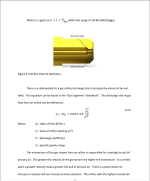Steve Hoch
TVWBB Olympian
I imagine that if you had a vast collection of orifices in varying sizes you could eventually dial a grill in to your liking. I would personally rather just get the correct manifold and avoid the hassle.
And as far as cooking goes, that seems acceptable. Not so much for warming, though.
What is the orifice size on the NG valve converted to LP? NVM, it doesn't matter on LO.
As long as the LO orifice (drilled hole) in the valve spool is smaller than the orifice at the exit of the valve, I think changing the exit orifice would have a minimal effect on LO temps. And the drilled hole is larger on the NG spool, and it needs to be smaller, so you're kind of stymied there. Changing the exit orifice would mostly affect the HI end of things, to my way of thinking.I imagine that if you had a vast collection of orifices in varying sizes you could eventually dial a grill in to your liking. I would personally rather just get the correct manifold and avoid the hassle.
I imagine that if you had a vast collection of orifices in varying sizes you could eventually dial a grill in to your liking. I would personally rather just get the correct manifold and avoid the hassle.
I've seen that mentioned before, probably by you. Can you tell any difference between them just looking at them?Yeah, I agree the proper way is to get the correct manifold. Price and availability have been an issue.
Looks like burners are different for the NG version and the LP version. They sure look the same to me but they are listed separately.
LP: https://www.grillparts.com/weber/2011_genesis_300.asp?product_id=62752
NG: https://www.grillparts.com/weber/2011_genesis_300.asp?product_id=62799
I've seen that mentioned before, probably by you. Can you tell any difference between them just looking at them?
Agreed Joe, this is the kind of stuff that always holds my interest.Very nice write up and testing! This is a great thread.
This is why when I see anybody mention anything about drilling out orifices to a certain size I cringe. There is just no way you can accurately and cleanly drill one of those out at home and expect good results.I read part of a research paper on gas burners, and there is so much more involved in this than what we mere mortals can ever understand. One of the smart things I think you did was buy a kit where the holes were already pre-sized. Sure, it's just a hole, but like the crown at the end of a gun barrel, the hole being precisely sized, being round and not oval and precisely in the center, along with a lead or exit chamfer, all those things have a lot to do with the way the burner performs.

I probably would enjoy that book, but not for $800. What's that about?For the intrepid, or merely curious, here is the research paper I mentioned earlier. A sample page dealing with orifices:
View attachment 55185
And if you think you might enjoy reading the Gas Engineer's Handbook, it's available, in Used condition, on Amazon for the low price of $799.50 + shipping.
Gas Engineers Handbook: Segeler, C George: 9780831130114: Amazon.com: Books
Gas Engineers Handbook [Segeler, C George] on Amazon.com. *FREE* shipping on qualifying offers. Gas Engineers Handbookwww.amazon.com
I suspect that these are date codes. Seems to match up with your 2016 dates, even if the top one is "15'.The manifolds appear to be identical. There is a number stamped on the bottom. Not sure if it is a part number or ?
LP: 060115
NG: 030116
Edit: I think the LP manifold may be 060116 but I cannot tell for sure.
View attachment 55160
View attachment 55158
Larry - That is a great summery. I find the vast majority of people want to convert from NG to Propane as NG grills are hard to sell and are easier to get cheap. According to the Hearth, Patio & Barbecue Association 9% of grills are NG (2020). Very good article about the state of the BBQ industry here. https://www.globenewswire.com/news-...ins the most popular,have a wood pellet grill.I did a full blown write up on all this a long time ago. Chris incorporated much of it into the read only thread he created. Bottom line. If you have an LP grill and try to convert to NG with only orifices you MIGHT not WILL have an unsafe situation. Low and medium but low in particular will not flow well enough to keep a burner lit steady. Which could cause a flame out. Now, one might say "Who cares?" but that is foolish. Because you still have gas flowing. Just not sufficiently to keep that burner lit. But, perhaps another burner IS lit. Now raw gas is building up in presence of a flame. It will build up enough to get "lit" but not the way you'd like or expect.
Conversely convert a NG to LP and you will get little to no difference LO to MED and excessively high temps making the grill hard to control. Unsafe? No, not at all. Inconvenient is all. But the opposite is definitely unsafe.
• Gas remains the most popular fuel, with 61% of grill owners using propane, followed by charcoal (49%), which has increased slightly since 2017 (45%).
o 9% have natural gas grill.
• One in 10 grillers have a full outdoor kitchen, and 56% of these individuals use that kitchen at least once a week.
